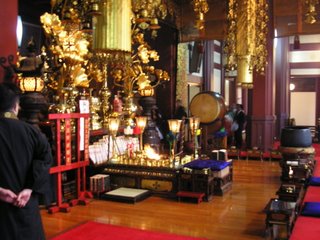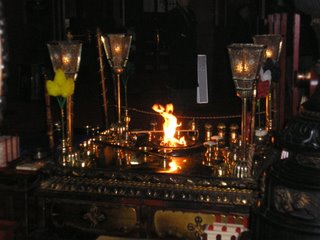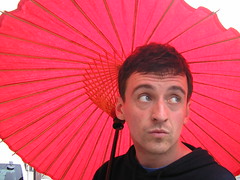Shinto
You would not believe the number of times I've tried to write this entry...Shinto (the way of the Gods) is a polymorphous, multi-headed beastie, and concisely defining it is a task Herculean in stature.

An indigenous form of Animism, it centres around the worship of the natural world and its elements, particularly those that inspire awe, such as mountains, waterfalls, dense forests, cloud formations, fire and even other human beings. These inspiring phenomena have associated, or are themselves "Kami"; divine beings.
 Shinto isn't the sort of religion one can just convert to willy-nilly, not least of all because it has been known to emphasise the divinity of the Japanese people (surely, if not the root, then at least the soil of their cultural pathology), but also because it isn't really organised in such a way. It sometimes seems inappropriate to even describe Shinto as a religion. It's more of an attitude, an outlook, a way of seeing the world and behaving. An optimistic, positive view of an unspoken status quo that simply is. Shinto has no creed, no sacred texts, no attempts to win converts. Its life blood is a cycle of observances with an absurd amount of Gods. Although all the Japanese I've spoken to about Shinto wouldn't describe themselves as religious, they still take part in the array of festivals and ceremonies that are steeped in magical-religious ritual. This may also have something to do with the unquenchable group ethic.
Shinto isn't the sort of religion one can just convert to willy-nilly, not least of all because it has been known to emphasise the divinity of the Japanese people (surely, if not the root, then at least the soil of their cultural pathology), but also because it isn't really organised in such a way. It sometimes seems inappropriate to even describe Shinto as a religion. It's more of an attitude, an outlook, a way of seeing the world and behaving. An optimistic, positive view of an unspoken status quo that simply is. Shinto has no creed, no sacred texts, no attempts to win converts. Its life blood is a cycle of observances with an absurd amount of Gods. Although all the Japanese I've spoken to about Shinto wouldn't describe themselves as religious, they still take part in the array of festivals and ceremonies that are steeped in magical-religious ritual. This may also have something to do with the unquenchable group ethic. The phrase "kuroshi toki no kamitanomi" (in times of trouble, turn to the Gods) sums up the Japanese attitude towards Kami worship. There are thousands of Kami, each one representing a different facet of life. If one wants a good yield of rice, then offerings must be made to Inari. Fisherman pray to Ebisu for a successful trip, whilst earthquake Kami must be appeased to avoid destruction of a new building for example. Such practices are still carried out in modern Japan. As late as 1972, many Japanese people relied on an almanac, highlighting days with a proclivity towards bane or blessing, in order to plan activities for the coming year. Organising a wedding for one of the days marked "Butsumetsu" (Buddhas' death) would be disastrous, as would holding a funeral on "Tomobiki" (bring a friend).
 In Shinto, or Animism in general, there is a continuity between the mundane and the divine, blurring the edges between the sacred & secular. As you'd expect, the Japanese have a definite hierarchy based on the benefits each Kami brings to man. In Japans' agricultural past, Kitsune, the fox messenger of Inari, was considered particularly important. Kami such as this, along with the more malevolent variety, had to be appeased in order for man to live in harmony with nature, another Shinto ideal. Sin is equated with disease, natural disasters (of which Japan has its share) and other such calamities, created by a failure to appease the deities.
In Shinto, or Animism in general, there is a continuity between the mundane and the divine, blurring the edges between the sacred & secular. As you'd expect, the Japanese have a definite hierarchy based on the benefits each Kami brings to man. In Japans' agricultural past, Kitsune, the fox messenger of Inari, was considered particularly important. Kami such as this, along with the more malevolent variety, had to be appeased in order for man to live in harmony with nature, another Shinto ideal. Sin is equated with disease, natural disasters (of which Japan has its share) and other such calamities, created by a failure to appease the deities.The standard creation myth (from the earliest records of the nation, the Kojiki and Nihongi) has Japan being made by Izanagi no Mikoto (creator or welcoming God) and Izanami no Mikoto (creator or welcoming Goddess). This creation was entrusted to them by the other Heavenly deities.
 From the Floating Bridge of Heaven, they dipped the Heavenly Jewelled Spear into the ocean. The brine that dripped from the spears point became the island of Onogorojima (located near one of the two Poles if you want to be specific), where the two were wed. Izanami gave birth to the islands of Japan, along with thirty-five other deities, but in bringing forth the Fire God, she was horrifically burned and died. Some versions of the story have the Gods of metal, earth, water and youthful reproduction being born from her excretia.
From the Floating Bridge of Heaven, they dipped the Heavenly Jewelled Spear into the ocean. The brine that dripped from the spears point became the island of Onogorojima (located near one of the two Poles if you want to be specific), where the two were wed. Izanami gave birth to the islands of Japan, along with thirty-five other deities, but in bringing forth the Fire God, she was horrifically burned and died. Some versions of the story have the Gods of metal, earth, water and youthful reproduction being born from her excretia.In an attempt to rescue his beloved, Izanagi ventures into Yomi no Kuni, the land of the dead. Echoing Orpheus, he looks upon Izanamis' face, despite her pleas for him not to. Greeted with her scorched features, he flees, pursued by the minions of the dead and escapes, blocking the entry to Yomi no Kuni with a huge boulder, thus separating the two lands.
Tainted and defiled by his journey, he bathes, this act eventually taking form in the many Shinto purification rituals. From each drop of cleansing water, a new deity is born - the Gods of the moon, oceans or storms (depending on which version you're reading) and most significantly Amaterasu Omikami, the Goddess of the sun. It is Ninigi, a descendant of Amaterasu, who receives control of Japan. History and myth become one in Ninigis' grandson, Jimmu, the first historical Emperor of Japan.
That's not quite Shinto in a nutshell...although on the whole, it's a fairly shapeless affair, it became the state religion during the Meiji restoration of the late 19th & early 20th century. Also, other religions have put down roots in the Japanese spiritual make-up, the incalculable influence of Buddhism, which gave Japan its first system of writing, being just one example...but this entry's already massive and it doesn't get any simpler...
Photos from Mount Mitake, Kawasaki Daishi & Sojiji, Tsurumi
Labels: culture (shock), folklore, Japan, religion



5 Comments:
No cocks, no comments it would seem
These photos are great; especially the one of the bell (?) with the kanji on it. Did you take them yourself? Is all of that located in Kawasaki?
Thanks. The first photo is from Mount Mitake, north of Tokyo I think, but you mustn`t trust my geography. The bell is from Sojiji shrine in Tsurumi, somewhere between Kawasaki & Yokohama...everything else comes from Kawasaki Daishi, but don`t let them deceive you - the place is an industrial smudge. Cheers for stopping by.
Well, written! The bell(?) seems to belong to a Buddhist temple or a Shito shrine in Tsurumi, Yokohama (next to Kawasaki). The inscription on the bell (in Kanji) shows when it was made and it was funded by the Imperial family...
Indeed, Japanese are very sensitive to the religiosity of Shinto because the Japanese government made it into an institutional religion after the Meiji Restoration and it gave the major ideological support to the fascist movement before and during the WWII.
Although ordinary Japanese sees Shinto more as a custom, the Shinto priests still tends to be ultra-nationalistic. I know it very well because I am from a Shinto clan...
where the hell do you find time to research and write these things i'm finding it hard enough to find time to post photos! yet alone think about them yet alone write a text book!!
Keep up the good work
www.roadragebunny.com
Post a Comment
<< Home